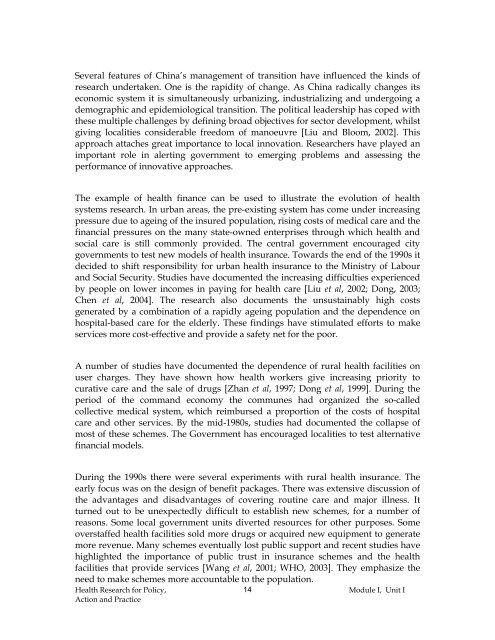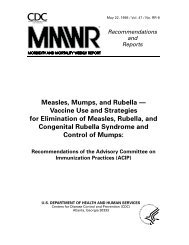Health Research for Policy, Action and Practice - The INCLEN Trust
Health Research for Policy, Action and Practice - The INCLEN Trust
Health Research for Policy, Action and Practice - The INCLEN Trust
- No tags were found...
You also want an ePaper? Increase the reach of your titles
YUMPU automatically turns print PDFs into web optimized ePapers that Google loves.
Several features of China’s management of transition have influenced the kinds ofresearch undertaken. One is the rapidity of change. As China radically changes itseconomic system it is simultaneously urbanizing, industrializing <strong>and</strong> undergoing ademographic <strong>and</strong> epidemiological transition. <strong>The</strong> political leadership has coped withthese multiple challenges by defining broad objectives <strong>for</strong> sector development, whilstgiving localities considerable freedom of manoeuvre [Liu <strong>and</strong> Bloom, 2002]. Thisapproach attaches great importance to local innovation. <strong>Research</strong>ers have played animportant role in alerting government to emerging problems <strong>and</strong> assessing theper<strong>for</strong>mance of innovative approaches.<strong>The</strong> example of health finance can be used to illustrate the evolution of healthsystems research. In urban areas, the pre-existing system has come under increasingpressure due to ageing of the insured population, rising costs of medical care <strong>and</strong> thefinancial pressures on the many state-owned enterprises through which health <strong>and</strong>social care is still commonly provided. <strong>The</strong> central government encouraged citygovernments to test new models of health insurance. Towards the end of the 1990s itdecided to shift responsibility <strong>for</strong> urban health insurance to the Ministry of Labour<strong>and</strong> Social Security. Studies have documented the increasing difficulties experiencedby people on lower incomes in paying <strong>for</strong> health care [Liu et al, 2002; Dong, 2003;Chen et al, 2004]. <strong>The</strong> research also documents the unsustainably high costsgenerated by a combination of a rapidly ageing population <strong>and</strong> the dependence onhospital-based care <strong>for</strong> the elderly. <strong>The</strong>se findings have stimulated ef<strong>for</strong>ts to makeservices more cost-effective <strong>and</strong> provide a safety net <strong>for</strong> the poor.A number of studies have documented the dependence of rural health facilities onuser charges. <strong>The</strong>y have shown how health workers give increasing priority tocurative care <strong>and</strong> the sale of drugs [Zhan et al, 1997; Dong et al, 1999]. During theperiod of the comm<strong>and</strong> economy the communes had organized the so-calledcollective medical system, which reimbursed a proportion of the costs of hospitalcare <strong>and</strong> other services. By the mid-1980s, studies had documented the collapse ofmost of these schemes. <strong>The</strong> Government has encouraged localities to test alternativefinancial models.During the 1990s there were several experiments with rural health insurance. <strong>The</strong>early focus was on the design of benefit packages. <strong>The</strong>re was extensive discussion ofthe advantages <strong>and</strong> disadvantages of covering routine care <strong>and</strong> major illness. Itturned out to be unexpectedly difficult to establish new schemes, <strong>for</strong> a number ofreasons. Some local government units diverted resources <strong>for</strong> other purposes. Someoverstaffed health facilities sold more drugs or acquired new equipment to generatemore revenue. Many schemes eventually lost public support <strong>and</strong> recent studies havehighlighted the importance of public trust in insurance schemes <strong>and</strong> the healthfacilities that provide services [Wang et al, 2001; WHO, 2003]. <strong>The</strong>y emphasize theneed to make schemes more accountable to the population.<strong>Health</strong> <strong>Research</strong> <strong>for</strong> <strong>Policy</strong>,14Module I, Unit I<strong>Action</strong> <strong>and</strong> <strong>Practice</strong>
















